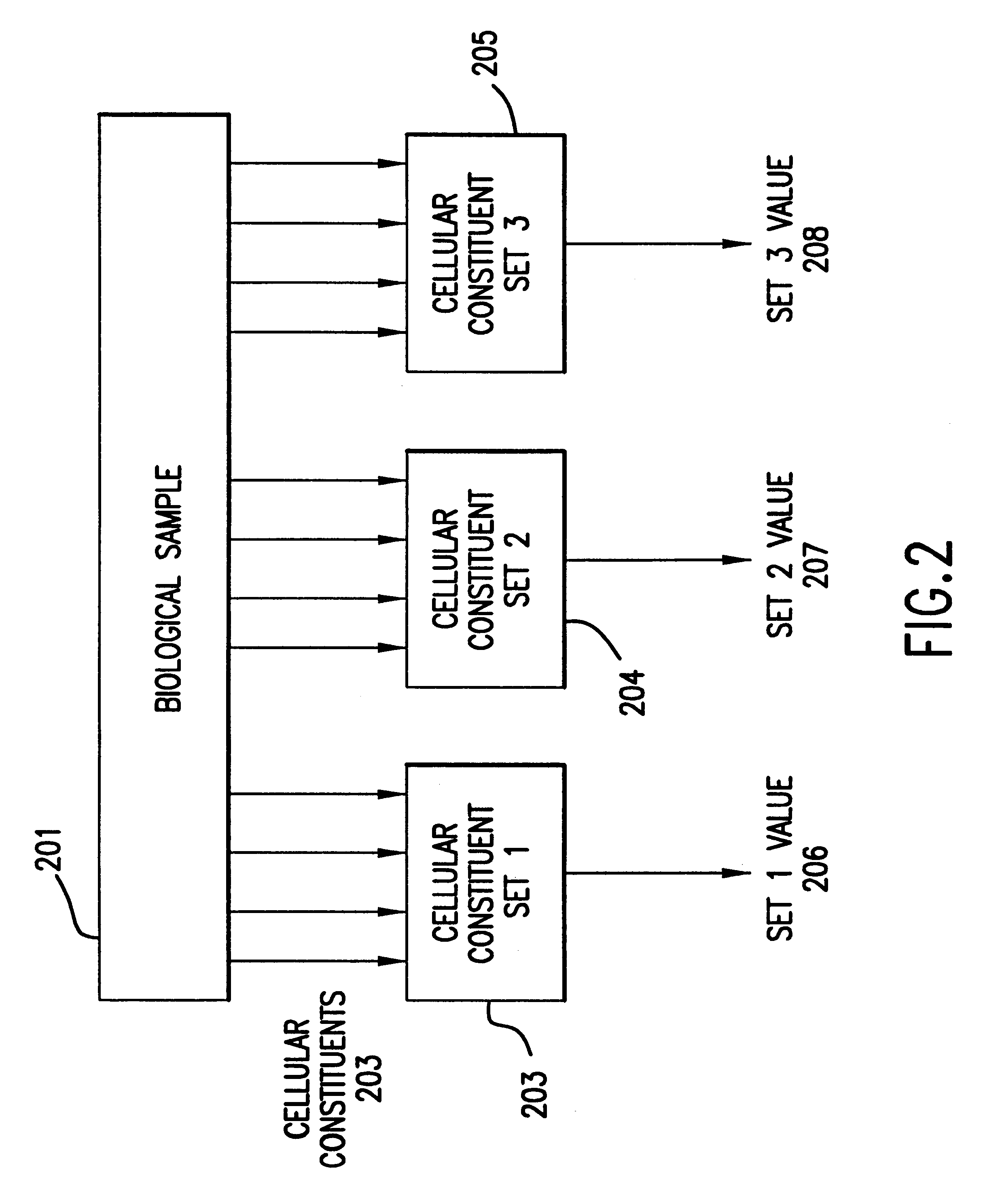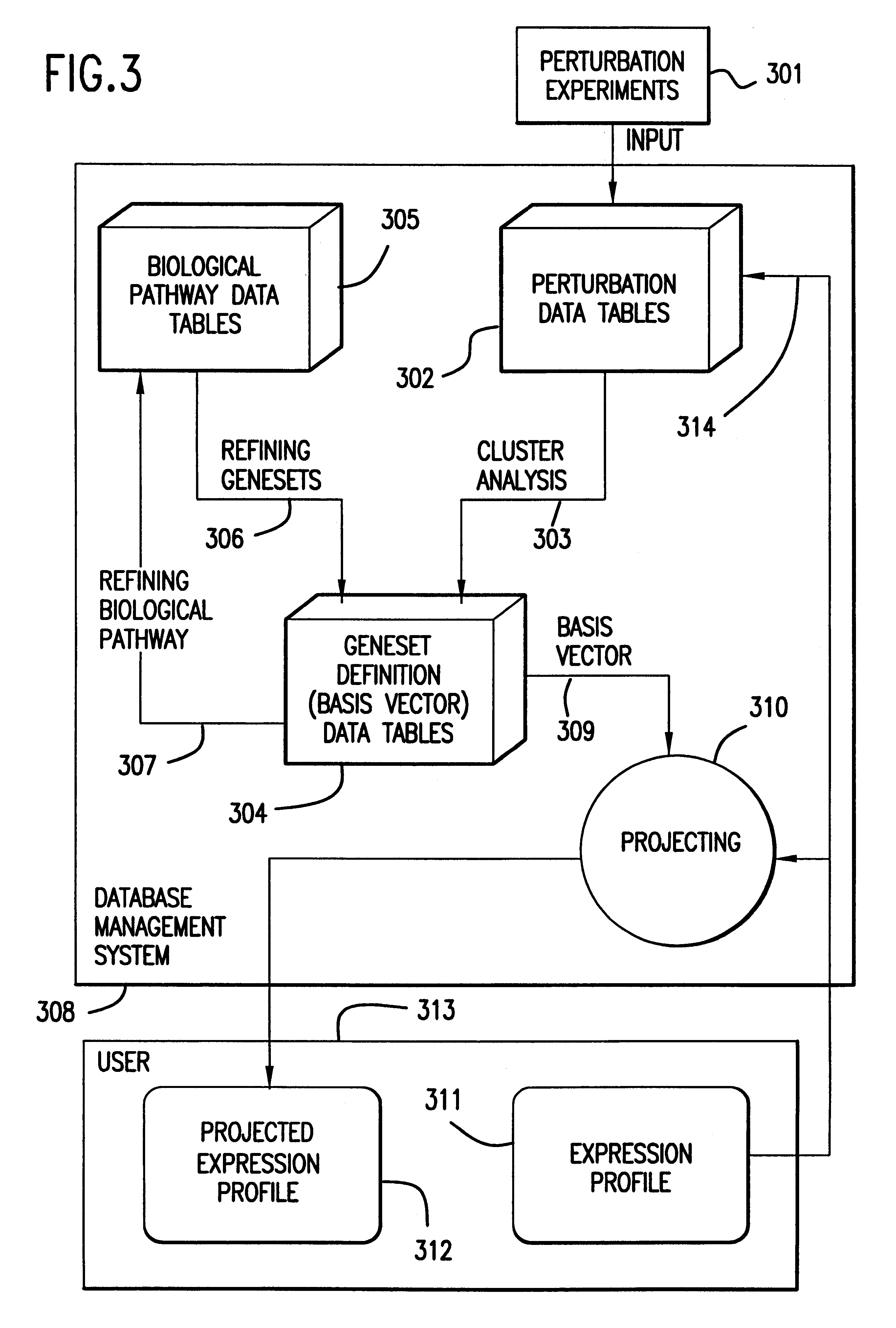Methods for using co-regulated genesets to enhance detection and classification of gene expression patterns
a gene expression and co-regulated technology, applied in the field of enhanced detection of biological responses to perturbations, can solve the problems of high rate of measurement error, high complexity of cell profile, and difficulty in analyzing biological response data, so as to reduce the dimension of data set, and reduce the risk of data loss
- Summary
- Abstract
- Description
- Claims
- Application Information
AI Technical Summary
Problems solved by technology
Method used
Image
Examples
example 1
6.1 Example 1
Clustering Genesets by Coregulation
This example illustrates one embodiment of the clustering method of the invention.
6.1.1 Materials and Methods
Transcript Measurement
Yeast (Saccharomyces cerevisiae, Strain YPH499, see, Sikorski and Hieter, 1989, A system of shuttle vectors and yeast host strains designated for efficient manipulation of DNA in Saccharomyces cerevisiae, Genetics 122:19-27) cells were grown in YAPD at 30.degree. C. to an OD.sub.600 of 1.0 (.+-.0.2), and total RNA prepared by breaking cells in phenol / chloroform and 0.1% SDS by standard procedures (Ausubel et al., 1995, Current Protocols in Molecular Biology, Greene Publishing and Wiley-Interscience, New York, Ch. 13). Poly(A).sup.+ RNA was selected by affinity chromatography on oligo-dT cellulose (New England Biolabs) essentially as described in Sambrook et al. (Molecular Cloning--A Laboratory Manual (2nd Ed.), Vol. 1, Cold Spring Harbor Laboratory, Cold Spring Harbor, N.Y., 1989). First strand cDNA synthes...
example 2
6.2 Example 2
Enhancing Detection of Response Pattern Using Geneset Average Response
This example illustrates enhanced detection of a particular response pattern by geneset averaging.
Geneset number 3 in the clustering analysis result of FIG. 6 involves genes regulated by the Gcn4 transcription factor. This was verified via the literature and via multiple sequence alignment analysis of the regulatory regions 5' to the individual genes (Stormno and Hartzell, 1989, Identifying protein binding sites from unaligned DNA fragments, Proc Natl Acad Sci 86:1183-1187; Hertz and Stormo, 1995, Identification of consensus patterns in unaligned DNA and protein sequences: a large-deviation statistical basis for penalizing gaps, Proc of 3rd Intl Conf on Bioinformatics and Genome Research, Lim and Cantor, eds., World Scientific Publishing Co., Ltd. Singapore, pp. 201-216). Twenty of 32 genes in geneset 3 had a common promoter sequence appropriate to Gcn4. These 20 were used to define a geneset. Respons...
example 3
6.3 Example 3
Improved Classification of Drug Activity
The 18-experiment data set mentioned in Example 1, supra, was combined with an additional 16 experiments using a variety of perturbations including immunosuppressive drugs FK506 and Cyclosporin A, and mutations in genes relevant to the activity of those drugs; and drugs unrelated to immunosuppression--hydroxyurea, 3-Aminotriazole, and methotrexate. The experimental conditions are listed in Table 3:
A cluster analysis was performed with the combined data set. A first down selection of genes was done by requiring the genes to have a significant response in 4 or more of the 34 experiments, where this threshold was defined precisely as greater than twofold up-down-regulation, and a confidence level of 99%, or better. This selection yielded 194 genes. Less stringent thresholds would yield more genes and higher incidence of measurement errors contaminating the data and confusing the biological identifications of the genesets; however, th...
PUM
| Property | Measurement | Unit |
|---|---|---|
| temperature | aaaaa | aaaaa |
| temperature | aaaaa | aaaaa |
| temperature | aaaaa | aaaaa |
Abstract
Description
Claims
Application Information
 Login to View More
Login to View More - R&D
- Intellectual Property
- Life Sciences
- Materials
- Tech Scout
- Unparalleled Data Quality
- Higher Quality Content
- 60% Fewer Hallucinations
Browse by: Latest US Patents, China's latest patents, Technical Efficacy Thesaurus, Application Domain, Technology Topic, Popular Technical Reports.
© 2025 PatSnap. All rights reserved.Legal|Privacy policy|Modern Slavery Act Transparency Statement|Sitemap|About US| Contact US: help@patsnap.com



